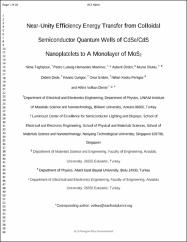| dc.contributor.author | Taghipour, Nima | |
| dc.contributor.author | Martinez, Pedro Ludwig Hernandez | |
| dc.contributor.author | Özden, Ayberk | |
| dc.contributor.author | Olutas, Murat | |
| dc.contributor.author | Dede, Didem | |
| dc.contributor.author | Güngör, Kıvanç | |
| dc.contributor.author | Demir, Hilmi Volkan | |
| dc.date.accessioned | 2019-10-22T16:58:44Z | |
| dc.date.available | 2019-10-22T16:58:44Z | |
| dc.date.issued | 2018 | |
| dc.identifier.issn | 1936-0851 | |
| dc.identifier.issn | 1936-086X | |
| dc.identifier.uri | https://dx.doi.org/10.1021/acsnano.8b04119 | |
| dc.identifier.uri | https://hdl.handle.net/11421/21588 | |
| dc.description | WOS: 000443525600107 | en_US |
| dc.description | PubMed ID: 29965729 | en_US |
| dc.description.abstract | A hybrid structure of the quasi-2D colloidal semiconductor quantum wells assembled with a single layer of 2D transition metal dichalcogenides offers the possibility of highly strong dipole-to-dipole coupling, which may enable extraordinary levels of efficiency in Forster resonance energy transfer (FRET). Here, we show ultra-high-efficiency FRET from the ensemble thin films of CdSe/CdS nanoplatelets (NPLs) to a MoS2 monolayer. From time-resolved fluorescence spectroscopy, we observed the suppression of the photoluminescence of the NPLs corresponding to the total rate of energy transfer from similar to 0.4 to 268 ns(-1). Using an Al2O3 separating layer between CdSe/CdS and MoS2 with thickness tuned from 5 to 1 nm, we found that FRET takes place 7- to 88-fold faster than the Auger recombination in CdSe-based NPLs. Our measurements reveal that the FRET rate scales down with d(-2) for the donor of CdSe/CdS NPLs and the acceptor of the MoS2 monolayer, d being the center-to-center distance between this FRET pair. A full electromagnetic model explains the behavior of this d(-2) system. This scaling arises from the delocalization of the dipole fields in the ensemble thin film of the NPLs and full distribution of the electric field across the layer of MoS2. This d(-2) dependency results in an extraordinarily long Forster radius of similar to 33 nm. | en_US |
| dc.description.sponsorship | Singapore National Research Foundation [NRF-NRFI2016-08]; Science and Engineering Research Council, Agency for Science, Technology and Research (A*STAR) of Singapore; TUBITAK [114F326, 115E679]; TUBA; TUBITAK BIDEB | en_US |
| dc.description.sponsorship | The authors gratefully acknowledge the financial support in part from Singapore National Research Foundation under the programs of NRF-NRFI2016-08 and the Science and Engineering Research Council, Agency for Science, Technology and Research (A*STAR) of Singapore, and in part from TUBITAK 114F326 and 115E679. H.V.D. also acknowledges support from TUBA. K.G. and O.E. acknowledge support from TUBITAK BIDEB. | en_US |
| dc.language.iso | eng | en_US |
| dc.publisher | American Chemical Society | en_US |
| dc.relation.isversionof | 10.1021/acsnano.8b04119 | en_US |
| dc.rights | info:eu-repo/semantics/openAccess | en_US |
| dc.subject | Semiconductor Nanocrystals | en_US |
| dc.subject | Colloidal Nanoplatelets | en_US |
| dc.subject | Molybdenum Disulfide | en_US |
| dc.subject | Fret | en_US |
| dc.subject | Distance Dependency | en_US |
| dc.subject | Forster Radius | en_US |
| dc.subject | Auger Recombination | en_US |
| dc.title | Near-Unity Efficiency Energy Transfer from Colloidal Semiconductor Quantum Wells of CdSe/CdS Nanoplatelets to a Monolayer of MoS2 | en_US |
| dc.type | article | en_US |
| dc.relation.journal | Acs Nano | en_US |
| dc.contributor.department | Anadolu Üniversitesi, Mühendislik Fakültesi, Malzeme Bilimi ve Mühendisliği Bölümü | en_US |
| dc.identifier.volume | 12 | en_US |
| dc.identifier.issue | 8 | en_US |
| dc.identifier.startpage | 8547 | en_US |
| dc.identifier.endpage | 8554 | en_US |
| dc.relation.publicationcategory | Makale - Uluslararası Hakemli Dergi - Kurum Öğretim Elemanı | en_US |


















